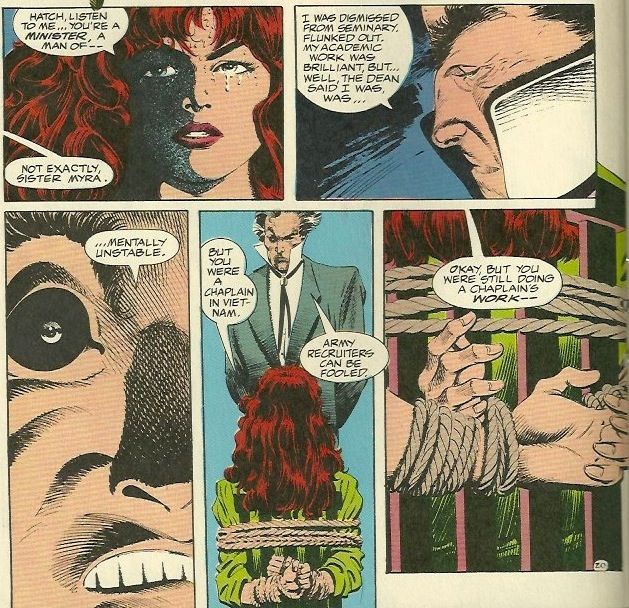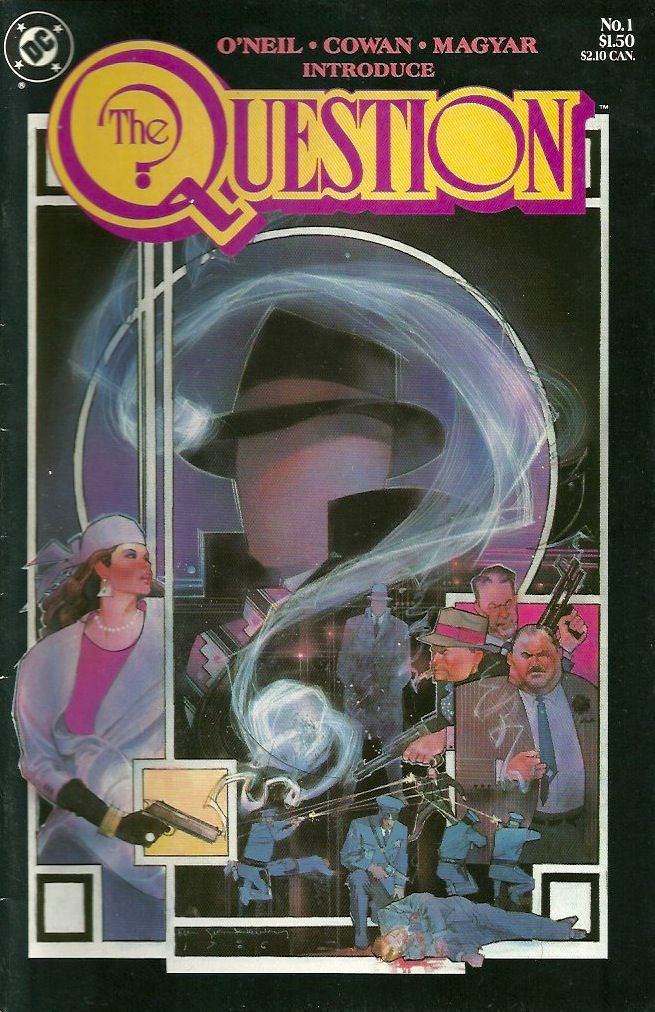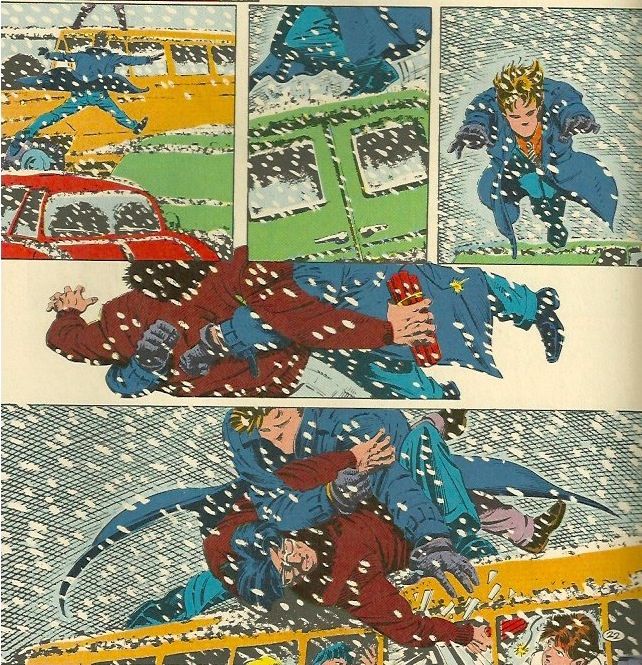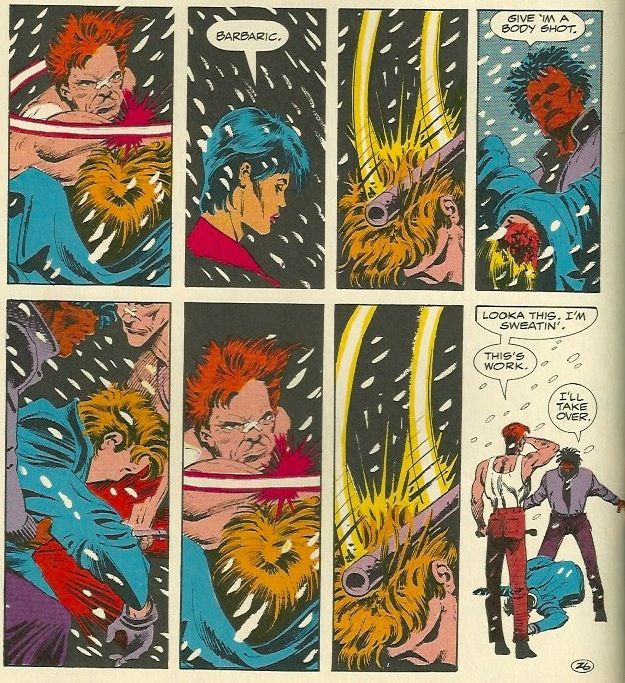A column in which Matt Derman (Comics Matter) reads & reviews comics from 1987, because that’s the year he was born. Click here for an archive of all the previous posts in the series.
The Question #1-4 (DC) by Dennis O'Neil, Denys Cowan, Rick Magyar, Tatjana Wood, Gaspar (#1, 3-4), Albert de Guzman (#2), Mike Gold
At the level of the most basic concept and plot, the opening few issues of 1987's The Question seem almost too simple to work. A guy who wants to improve his hometown accomplishes it by creating a superhero persona for himself, not based on any special powers or skills he has, nor even really because of any personal vendetta, but simply because with a mask and a codename he can get away with stuff that would be harder to pull off otherwise. His opponents are agents of the corrupt local government, which is officially run by a drunk and inept mayor, though in reality the mayor himself is controlled from the shadows by an insane reverend. None of this is inherently bad, but it doesn't scream originality, either, at least not on the surface. The creative team behind The Question uses the series' core simplicity to their advantage, though, producing something rich and nuanced despite the relatively straightforward foundation. Every villain, including several of the smalltime minions, has a full and distinct personality. The titular hero has a fascinating, somewhat tormented, and often contradictory internal life, so following his thought processes is always an interesting experience. The action sequences are gorgeous and well-choreographed, easy to follow but still visually gripping and unique. And all of this is made possible by the clean, clear narrative—because the larger story isn't all that complex, all of the players and individual scenes can be. It makes for some mighty fine reading, the sort of comic where every line of text and every new image pulls you in all over again. The ultimate destination of the narrative might be obvious up front, but the route it takes to get there, and the stops made along the way, are as surprising and exciting as anything I've read, from 1987 or any year.
The Question's secret identity is Vic Sage, whose real name is Charles Victor Szasz, a TV news reporter who isn't afraid to publicly criticize and expose the corruption that's running rampant in the local government of Hub City. To uncover this corruption, Sage becomes the Question, donning a faceless mask with a nice suit, tie, and hat combo, and punching his way through the bad guys until they give him the evidence he wants. Unsurprisingly, this makes a lot of people unhappy, namely Reverend Jeremiah Hatch, the man who's truly behind all the recent crimes and misdeeds amongst Hub City's elected officials. Hatch is the right hand man/puppet master of Mayor Wesley Fermin, a man is so drunk so often that it's not clear he even knows what Hatch is up to, much less understands it. All of this is already going on when the debut issue of The Question begins; Hatch is well established as the man with his hand on the wheel, and Sage has already done more than one report on the problems with Fermin's administration, meaning the Question has made more than one attack against Hatch's operation. Where things really kick off, then, is with Hatch's response, when he and a group of his goons set a trap for the Question and viciously beat him to death, breaking every bone in his body, shooting him in the head with an air gun, and throwing him into the river. That's actually how The Question #1 concludes, with the protagonist seemingly deceased, his battered body left underwater by his foes.
Of course, Sage doesn't die, and though the explanation of how he survives is perhaps a bit suspect, Dennis O'Neil writes it convincingly enough that it flies. Essentially, between the weakness of the air gun and the coldness of the water, Sage's body managed to keep him alive just long enough for him to be rescued by one of his attackers, the mysterious martial arts expert named Lady Shiva. Her reasons for saving him are left up in the air, so his survival is surrounded with various uncertainties, but that's actually a pretty perfect situation for a hero called the Question. After his miraculous return to life, Sage is sent by Shiva to train with Richard Dragon, and the two men spend a vague amount of time together (probably a few months) honing Sage's physical and mental skills alike, all while his body is recovering from its recent trauma. All of this transforms him into a more focused and effective hero, and he goes back to Hub City with a greater drive, a fiercer devotion to his cause than ever before.
There are several fights for the Question before he finally gets to take down Hatch, such as stopping a schoolbus full of children from being blown up, or battling a bunch of crooked cops. He has a few close calls here and there, but generally he manages to stay on top, overcoming each obstacle as they come until he can get at Hatch directly. Hatch, meanwhile, gets gradually crazier, or at least shows his craziness more and more as time goes on. It turns out Hatch isn't even technically a reverend, having been kicked out of seminary in his youth because of his extreme psychological instability. He then lied his way into a job as an army chaplain in Vietnam, which pretty much pushed him right over the edge into batshit territory, as war can do to anybody, let alone someone who was already unhinged before they got there. Hatch came to believe that in order to serve God, he would need to work for the Devil, engendering and creating as much evil and corruption in the world as he can until things get so terrible that God will have no choice but to smite us all with his righteousness. It's the sort of twisted, evil-in-the-name-of-good logic I always like to see in a villain, and Hatch is so self-important and melodramatic that it fits him like a glove. In the end, he plans to sacrifice a child to the Devil, a decision he makes only after the voice in his head tells him to. Even the fact that he hears voices is something we don't know until issue #4, so the true depths of his insanity may never be entirely revealed, but it's clear from the get-go that he's mad, power-hungry, and therefore incredibly dangerous.
Hatch is an amazing antagonist, wholly unlikable but still fun to spend time with, pure evil but with a reason and a story behind it. That said, it's all the other villains in this story that make it feel so full. The head henchman, Jacob, starts out as just another thug in the crowd, but little by little he develops his own arc wherein he grows sick of Hatch's ridiculousness and commitment to evil for evil's sake (as opposed to for the sake of getting rich). Jacob also forms a bit of a rivalry with the Question, because the two of them take a few turns beating the hell out of each other over the course of these issues. Jacob eventually tries to rob Hatch and run, but before he can make his escape, the Question shows up for one last fistfight, so Jacob ends up defeated like the rest of Hatch's crew. Even with this dead-end resolution, watching Jacob stew in his dissatisfaction and slowly but surely reach his breaking point is entertaining and unexpected.
There are a few other enjoyable baddies, like Junior, the nervous young man in issue #3 who is so determined to impress his infamous terrorist father that he punches through a glass window with a handful of dynamite to try and blow up a schoolbus. But the best of the bunch is Mayor Fermin, who isn't an active villain so much as a tool for the villains to use. He's not a good guy, by any means, but he's also not intelligent or aware enough to really participate in any of Hatch's plans. Fermin is just a doofus with a serious drinking problem and an almost childlike personality, wandering through his mansion without a care or a clue, giving Hatch all the access and power he needs.
The one thing Fermin does that truly matters is that he falls for Myra, another excellent and impressive member of this cast. Myra is a reporter who works with Vic Sage, and during the period when Sage was training with Richard, Myra gets forced into marrying Fermin. Hatch threatens to hurt Myra's daughter, Jackie, if she doesn't marry the mayor, and then later, it is Jackie who Hatch tries to sacrifice. Though having her child threatened and marrying someone against her will are certainly terrible, emotionally taxing experiences, Myra manages to keep her head above water the whole time. This puts her in an ideal position when the Question comes back on the scene to give him valuable assistance and information. She is an essential ally to him, quick-thinking and highly motivated. Indeed, it is Myra who ultimately kills Hatch, stabbing him in the back with the knife he planned to use on her daughter, mere seconds after the Question stated out loud that he would let Hatch live. It's a very brutal yet very satisfying moment, Hatch and Myra both getting something they deserve.
Supporting cast aside, the Question is a great lead character, compellingly conflicted but without it getting in his way. He wants to be (and is trained to be) this calm, centered, hyper-controlled guy, but he struggles with holding onto that attitude. His natural mode is to be flashier and more brazen, to go fists first into rooms full of armed opponents, to leave a calling card at the scene of every fight. He likes the showmanship involved in the masked vigilante lifestyle, and truth be told, he seems to rather like the violence as well. None of that quite lines up with the cool, level-headed figure he aspires to be, so he ends up a blend of his training and his instincts, equal parts collected and wild, a stoic man of few words, but only because he lets his fists do the talking for him. He's maybe a tad unstable and definitely too obsessive, but compared to people like Hatch, the Question is the poster boy for sanity. He's got all these near-opposing pieces of himself that come together to make a stellar whole, and to top it off, he always looks fantastic.
Denys Cowan's character designs are a huge part of why everyone in this book works so well; Hatch's mismatched eyes perfectly capture his craziness, Myra's wisdom and courage are abundantly evident whenever she's on the page, and even minor henchmen like Baby Gun and Donny have whole personalities expressed almost entirely by their physicalities and attire. The strongest example is Mayor Fermin, whose head is incessantly surrounded by bubbles of drunkenness, and whose clothing is never on all the way, his unbuttoned shirts and pants slipping and sliding off of his body to underline his general air of awkwardness and buffoonery. And the Question, who Cowan didn't design originally, looks just right here, firm and trim and confident, wearing his suit like he was born with it on, and expressing a full range of emotions despite his lack of facial features. Plus whenever the fighting starts, he's a total badass.
The action sequences in The Question #1-4 are spectacular, and surprisingly unlike one another considering many of them are just the Question vs. a handful of toughs. Cowan always finds new angles from which to view the violence, moves for the Question to use, and other means of keeping things fresh. The fights are paced differently, too, depending on the needs of the narrative. When the Question is being beaten to death, Cowan stretches out the agony by cramming numerous small, intimate panels onto the page, so that the reader sees and feels every hit that the Question has to take. On the other hand, when it's Hatch's turn to die, there is only a single, super-intense panel, taking up the whole bottom third of the page, of Myra stabbing him. Both of these are death scenes for major players, yet the space they occupy and the rhythm with which they play out could not be more different, one of many possible examples of Cowan's smart, carefully varied pacing when it comes to the book's violence. It always looks awesome, and it never looks the same.
As superhero concepts go, the Question isn't all that captivating, since he has neither cool powers and nor a particularly interesting origin story. He's a journalist who wants to do more, to be more, so he becomes a superhero almost at random (with a little help from his friend Tot, who I've completely neglected up to now, and for that I apologize...I guess he just didn't do it for me like the rest of the cast did). Through impeccable, intelligent character building from both O'Neil and Cowan, and the brilliantly executed fight scenes and other bursts of action, The Question manages to be bizarre, enthralling, and exceptional. These four issues are only the series' first arc, and they alone are dense and detailed enough to be read and reread multiple times without losing their appeal. It's standout work all over, and the best comicbook I've read for this column to date.




